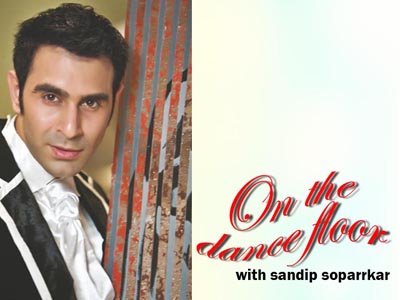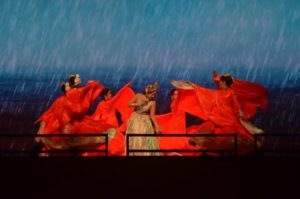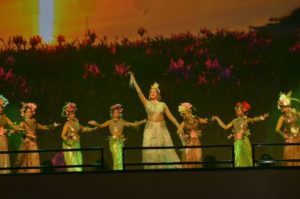Jai maa Gange

At the Kumbh Mela at Pragyaraj which recently ended as well as at the Pravasi Bharatiya Divas Convention in Varanasi, the “Dream Girl of Indian Cinema”, the super-stunning Padma Shri Hema Malini presented her larger-than-life dance ballet, Ganga.
The gorgeous dancer presented her ballet in the presence of Union External Affairs Minister Sushma Swaraj, chief minister of Uttar Pradesh Yogi Adityanath and thousands of international and national delegates and ministers. The 90-minute dance drama, based on the life of River Ganga from its birth till today, was marvellously presented by Hema Malini and her team of Natyavihar Kala Kendra. The show was in four parts: choreographed by Bhushan Lakandri, music composed by Padma Shri Ravindra Jain, Asit Desai and his son, Alaap while the songs were rendered by Suresh Wadkar, Kavita Krishnamurthy, Shankar Mahadevan and Mika Singh. The costumes were designed by Neeta Lulla, special effects were by Vibhore Khandelwal and it was directed by Hema Malini herself.
Hema Malini, dressed in sparking white and sliver clothes, narrated the age-old story of India’s holiest river. The show touched the parts of the birth of Ganga, her purpose of descending on earth, episodes of Ramayana and Mahabharata and finally moving on to the topic of Swachh Ganga and how it was getting polluted.
Part One
The divine Ganga, the one who emerged from the benevolent feet of Lord Vishnu and who resides in the lord’s precincts of Vaikunth Lok, is constantly disturbed by the frantic calls of despair emanating from the distant human world. Lord Vishnu reveals to Ganga that the voice of despair belongs to none other than King Bhagirath who seeks her divine decent on earth to help attain moksha of his ancestors but Ganga, who has always resided at the lotus feet of Lord Vishnu, expresses her unwillingness to depart from Vaikunth and the Lord. But the protector of the Universe, Lord Vishnu asks her vehemently to oblige to the great king and depart on her mission in the world of humans. After all, this was the reason for Ganga’s appearance.
Reluctantly she leaves for earth, thunderously coursing her way through the universe. At the behest of Lord Vishnu, Lord Brahma tries his utmost to contain Ganga’s powerful flow by obstructing her and trying to confine in her in his kamandal but fails miserably. Ganga gushes through his kamandal and flows away nonchalantly in her tempestuous pace. Lord Shiva, who is in deep penance in his abode of Mount Kailash, senses the arrival of Ganga and knowing that her uncontrollable flow could cause destruction on earth, arrests her in his jata (matted locks) and restricts her in its confines.
Ganga tries to break free but no avail. Lord Brahma emerges and appeals to Lord Shiva to free Ganga so that she can advance on her way to fulfill her mission on earth. Subsequently, Lord Shiva unfolds a single lock of hair and releases Ganga. On encountering the Lord, once released from his locks, Ganga is enchanted at the sight of the mighty Shiva and is completely mesmerised by Him. Not the one to give in to worldly emotions, Lord Shiva soon blesses Ganga and affectionately directs her to set off on her path. Ganga thus leaves Mount Kailash and proceeds to the mundane world.
Part Two
Meanwhile on earth, King Himvant is eagerly awaiting the arrival of Ganga. He welcomes her and accepts her as his child. Mother Earth is overjoyed and all of Nature welcomes Ganga. Humankind celebrates this joyous moment. King Bhagirath is overwhelmed to witness the outcome of his steadfast penance. Ganga had descended on Earth. Bhagirath reminds her of the reason for her advent on Earth and leads her on a mission of granting Moksha to the souls of his ancestors. Ganga obliges. Once this mission is fulfilled, Ganga is now ready to head back to Vaikunth and back to Lord Vishnu. Mother Earth implores her to stay on longer as her mission on Earth was much bigger than only granting Moksha. Venerable sages and common people come together to beseech Ganga’s blessings and pray that she stays on to give life and hope to mankind and destroy evils that emerge through various eras and times in the human world.
Part Three
Ganga’s sojourn on Earth begins and she is now a witness to the life and times and the ever-changing eras of the mortal world. She witnesses many yugas and the great lives associated with each yuga. Like King Harischandra in Satyuga, Lord Rama in Treta Yuga and the incarnation of Lord Krishna in Dwapar Yuga. As Ganga continues to flow peacefully through these ages, she encounters King Shantanu to whom she loses her heart and in due course, they accept each other in a conditional matrimony. This results in the birth of Bhishma. In the same era, Lord Krishna has taken birth and plays his various leelas in Gokul.
The era ends with the great war of Mahabharata. Ganga is shattered when she witnesses the death of her son, Bhishma. But the era was marked by victory of dharma (righteousness) over adharma (wickedness) which was established through the great war. Evil forces had begun their rule on Earth. They had gripped the planet and impacted the daily lives of human beings in the form of negative influences. The Earth itself was undergoing a time depicting absence of love, mercy, compassion, peace, truth, non-violence and was overpowered by the effects of potent forces. Ganga continues to flow through centuries fulfilling her duties and also witnesses the incarnations of Lord Buddha, Mahavira, Shankaracharya and Guru Nanak Dev. These noble souls helped mankind in alleviating the sufferings of the people who had for long been subjected to and had been reeling under the influence of negative forces.
The new era also depicts the period of British administrations. History unfolds with the narration of sporadic episodes of foreign invaders like the Turks, Khiljis, Lodhi and the Mughals who are hell bent on destroying the cultural ethos embedded in Indian society. The period of Indian War of Independence brings forth the bravery of Mangal Pandey who fights against the tyranny of British rule which led to the freedom of Indian on August 15, 1947.
Part Four
In the era after Independence, one can see the severe treatment inflicted on Ganga but Ganga refuses to die down. Ganga and her various tributaries have been reduced to almost extinction due to human selfishness and ignorance. Human greed and lust for power affect the very survival of this plant. Human activities for temporal worldly gains keep waging an onslaught on the purity, divinity and piousness for which Ganga is known. Ganga sees the planet plunging into the dark era and suffering the greatest form of anguish and agony. Ganga is enraged. She can no longer dear the decline of life on Earth caused by mankind.
An enraged Ganga threatens to leave the planet but is touched by the heartfelt prayers and pleas of people who care for their world. She is touched by the little children who are yet to experience this beautiful world and she decided to stay back to help the planet become a better place and a haven for the generations who are yet to arrive.
Ganga forgives all those who did not treat her well and resolves to maintain her purity for the sake of the people. The Yuga of Kali has to end. People should no longer challenge the laws of Nature for transient gains. Ganga promises to restore herself to her original state of glory. She bestows her benevolence on humankind against the sounds of drums and bells and voiced chanting the great Ganga Aarti.
On witnessing the show, Sushma Swaraj said, “I don’t have words about Hema Maliniji’s performance, first time ever in my life, I am taking three words from famous television show for your performance – adbhut, avishwasniya and akalpaniya (wonderful, unbelievable and unimaginable).
Talking about Ganga, Hemaji said, “Ganga had always been by dream project. However, I had lost hope for it when music director Ravindra Jainji passed away. In fact, when he fell sick, he had suggested me that I should record a few songs on ‘Ganga’ and keep it. I did record a few tracks which Esha and Ahana performed as solo item numbers in shows. But for a full-fledged dance ballet, I was looking for someone who would understand the soul of the subject. That’s when popular music director Ashit Desai came on board.”
Talking further about Ganga, Hemaji said, “I was in search of a new choreographer for ‘Ganga’ as Bhushan Lakandri had decided to relocate from Mumbai but then I insisted and asked Bhushanji to comeback for the sake of ‘Ganga’. I am glad he did and what he has created is magnificent. I just can’t imagine anyone other than Bhushanji for my ballets, he has been with me since my first ballet Ramayana three decades ago. It’s more than 30 years of association with him and he knows what I want in terms of steps and movements.”
‘Ganga’ is one wholesome dance ballet that takes the audience from era to era beautifully narrating the story of Maa Ganga. Hema Malini plans to take her new baby to every major city of India and to a few international destinations too and through her unmatched dance and acting skills she wishes to spread the vital and significant message of rich Indian mythological tales and more importantly the message of Swachh (clean) Ganga a mission of our Prime Minister Narendra Modi.
Sandip Soparrkar holds a doctorate in world mythology folklore, is a World Book Record holder, a well known Ballroom dancer and a Bollywood choreographer who has been honoured with three National Excellence awards and one National Achievement Award by the Government of India. He can be contacted on sandipsoparrkar06@gmail.com




